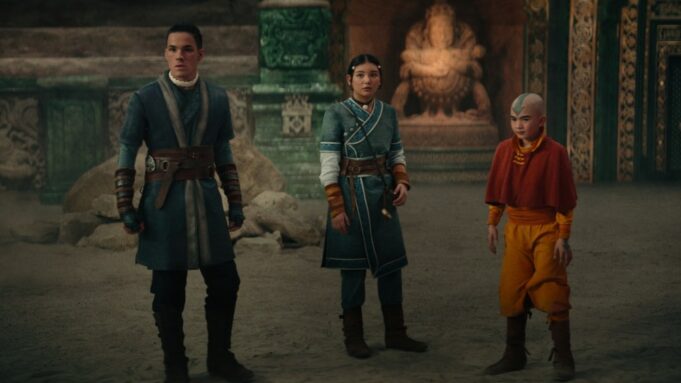Ever since its premiere nearly two decades ago, “Avatar: The Last Airbender” has been a fan favorite animated franchise. Co-created by Michael Dante DiMartino and Bryan Konietzko, the original series garnered critical acclaim and spawned an extended universe. That’s why there was much to anticipate when Netflix announced a “reimagined” live-action “Avatar” television series, helmed by DiMartino and Konietzko as co-showrunners and executive producers. Unfortunately, that euphoria was short-lived, as the pair left the project over what was described as “creative differences.”
Now, with “Sleepy Hollow” showrunner Albert Kim at the helm as creator, writer, and showrunner, Netflix has finally debuted its long-delayed take on “Avatar: The Last Airbender.” And although the series is far from the mess that was M. Night Shyamalan’s ill-conceived and white-washed film adaptation, it will leave fans wishing the streamer had left DiMartino and Konietzko’s masterpiece alone.
Tasked with adapting the animated series’ first season of 20 episodes into just eight hours, the live-action “Avatar” starts promisingly enough. After living in harmony for millennia, the power-crazed Fire Nation, led by Fire Lord Sozin (Hiro Kanagawa), rises against the world’s other three nations — the Water Tribes, the Earth Kingdom and Air Nomads — in a ploy for domination. Using stunning CGI and special effects, the series’ prologue is recounted in majestic color, explaining the history of the war and precocious Airbender Aang’s (Gordon Cormier) life before he goes missing. It’s a dynamic entry-point for lifelong “Avatar” enthusiasts and newcomers, who can quickly orient themselves in the days before Aang, who learns he is the Avatar (the master of all four elements), is frozen in the ice for 100 years. The Avatar’s absence allows the Fire Nation’s comet-fueled war to rage on, obliterating the Air Nomads and wreaking havoc on the Water Tribes and the Earth Kingdom.
Twenty minutes into the first chapter, “Avatar” flashes forward a century. Katara (Kiawentiio), the sole water bender of the Southern Water Tribe, and her over-protective brother Sokka (Ian Ousley) stumble upon Aang’s resting place, inadvertently awakening him. Though initially apprehensive, the pair embrace Aang as their friend and join him on his quest to master the other elements, end the Fire Nation’s war and restore balance to the world.
While the show’s visuals and its Asian and Indigenous stars add authenticity to the series, the performances of the majority of the cast, no matter how earnest, don’t hold up to the weight of the narrative. Many of the series’ portrayals lack the extensive emotion needed to carry a show centering on the horrors of genocide, war and totalitarianism. Tonally, “Avatar: The Last Airbender” should stand alongside the nuanced sophistication of the “Harry Potter” movie adaptations or Disney+’s “Percy Jackson and the Olympians.” But instead, cheesy acting and some Disney Channel-like dialogue turn what could have been a resounding epic adventure into a whimpering thud.
As with many live-action films and television adaptations from written or animated sources, Kim and his writers’ room conflated and combined several pivotal narrative beats. However, entwining Jet’s (Sebastian Amoruso) story of freedom fighting with the Earth Kingdom’s sparkling city Omashu and the tale of King Bumi (Utkarsh Ambudkar) feel rushed and overly convenient – especially for those who know the original series well. Moreover, stripping Sokka of the comic relief that enriched the animated version of his character is hugely disappointing and makes for a more one-note depiction.
Despite these missteps, there are a few standout moments in the series. “Avatar’s” opener and its second episode, “Warriors,” remain the two strongest installments of the show, while the penultimate episode (“The North”) injects a vital intenseness and a gorgeous display of water bending needed to reinvigorate the series in its final hours. And despite many of the series’ lackluster performances, Elizabeth Yu’s turn as the cunning and volatile Princess Azula — who is desperate to impress her father, the sadistic Fire Lord Ozai (Daniel Dae Kim), and outsmart her exiled older brother Prince Zuko (Dallas Liu) — is by far one of the most powerful showcases of the series. Also, Paul Sun-Hyung Lee’s role as Uncle Iroh tempers the tone of many scenes that bend toward melodrama in the hands of more novice actors.
Love Film & TV?
Get your daily dose of everything happening in music, film and TV in Australia and abroad.
Looking back on the original, animated “Avatar,” it’s clear that DiMartino and Konietzko had a distinct vision for Aang and this universe. Without their careful guidance, the live-action series loses the elements that made the animated work unique and refined. Ultimately, “Avatar: The Last Airbender” feels like it’s putting on a show, instead of meticulously immersing the audience in this stunningly crafted world.
“Avatar: The Last Airbender” premieres Feb. 22 on Netflix.
From Variety US































